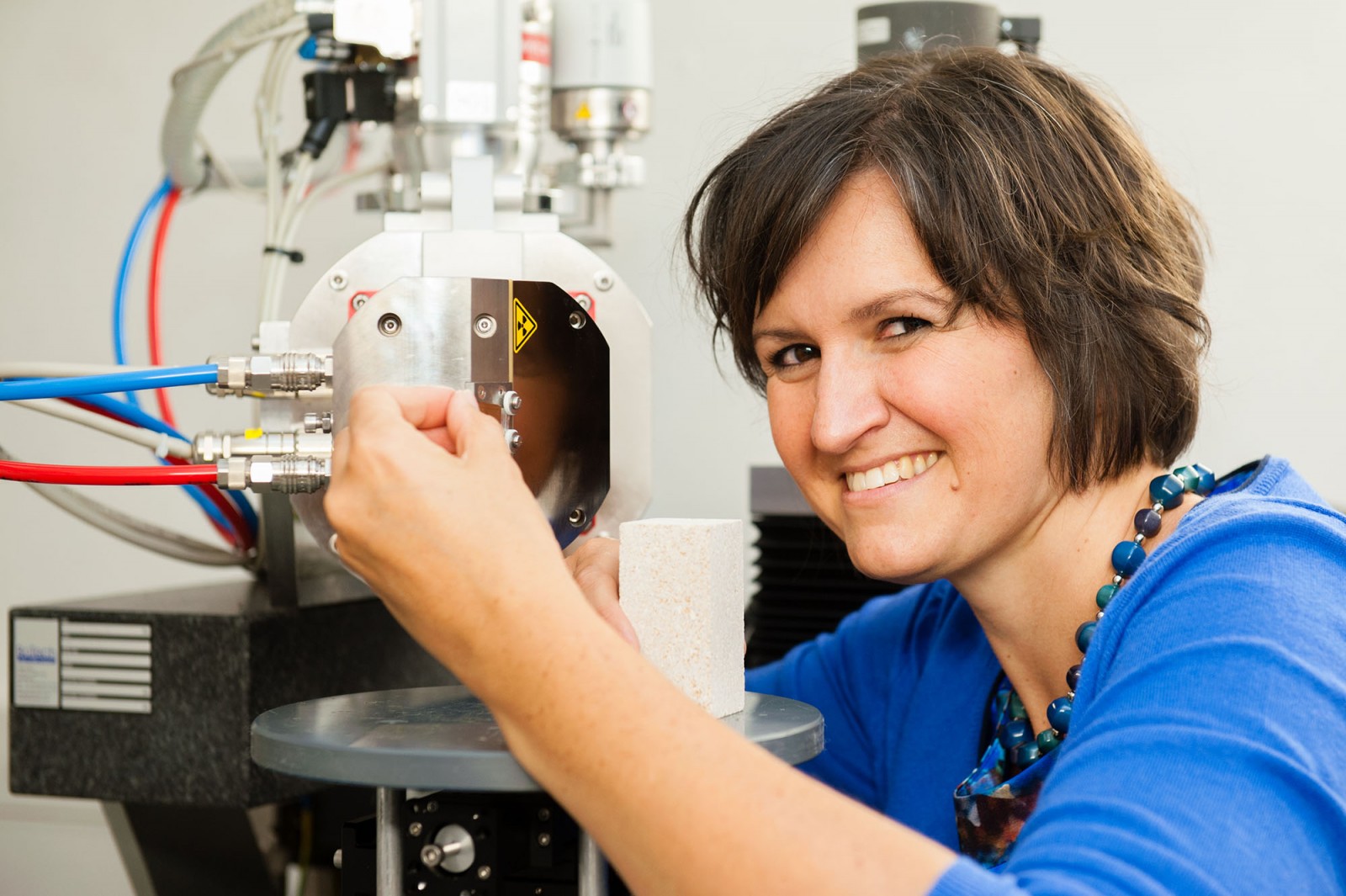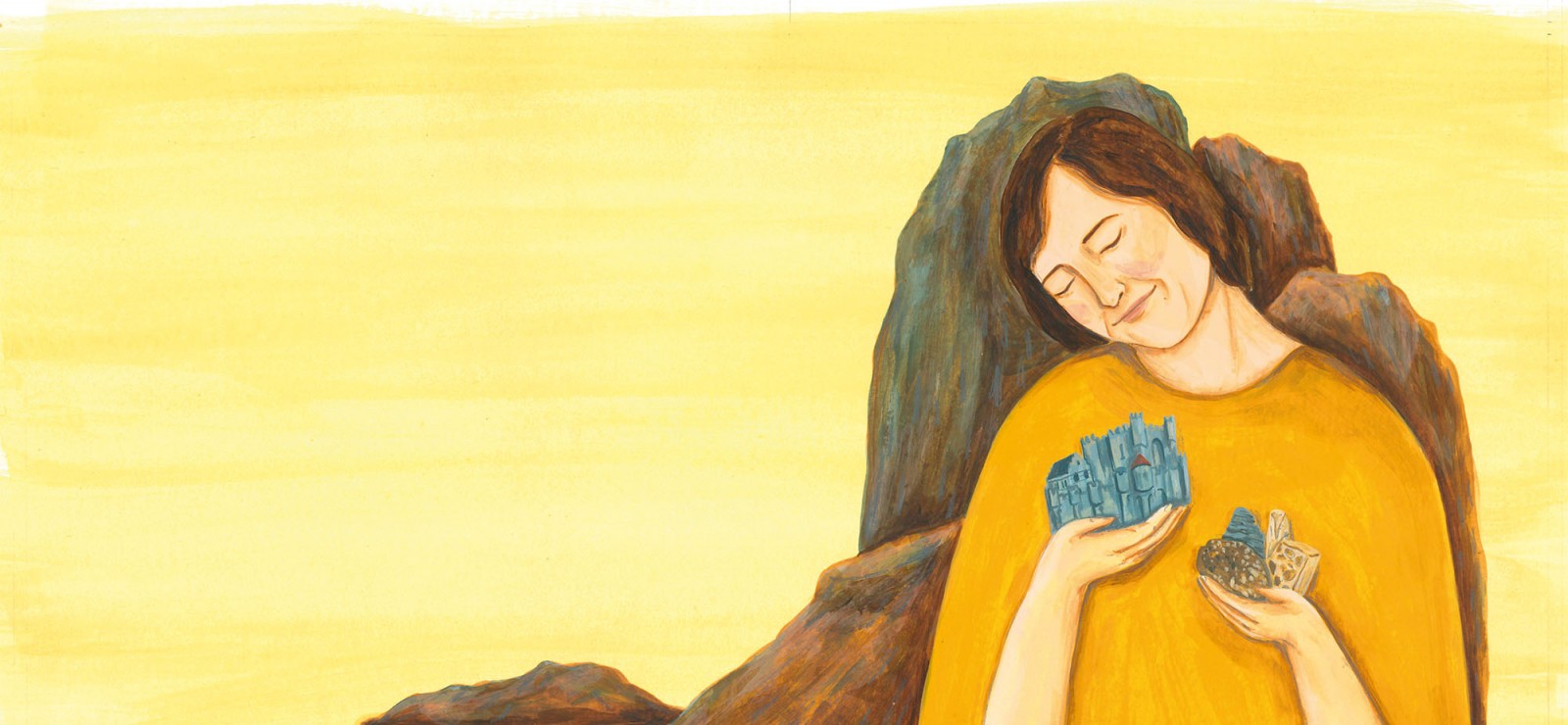Professor Veerle Cnudde’s smartphone is full of photos of old, weathered stones. Mostly of natural stones, used in the construction of old buildings like the Gravensteen, as the aim of her research is to better protect the stones – and therefore the buildings too. Because “if you simply leave them in their current condition, over time there won’t be much left.”
“No, I hadn’t originally thought I’d end up in the geology field. (laughs) Even though it was ingrained in me from an early age. My father is a professor of geology, and although I was interested in the subject too, at that point I didn’t yet know if it was my true calling. I realise now that it is. Every day, I get to combine my different passions and interests. That’s the wonderful thing about geology: it draws together multiple disciplines.”
Veerle Cnudde's passions and interests relate to the inside of natural stones, more specifically to the minerals and the pores that they contain. She specialised in creating 3D images of them and was recently awarded two prestigious grants for her research, which should lead to fresh insights into and better conservation methods for natural stones.
First off, you don’t just look at stones, but actually in stones. Where do you start?
“When I was studying geology, Professor Patric Jacobs pointed out a new technology to me: 3D X-ray tomography. This could be used to look inside natural stones, in the same way that you use X-rays to look inside patients for medical purposes. I became really intrigued by this, did my PhD on it, and wanted to go one step further than what the devices were capable of at that time. I wanted to see live what happens to the minerals inside the stones under the influence of various environmental factors, such as a change in temperature, increased rainfall, and the effect of consolidants and water-resistant products. Consolidants are products that ensure that the particles in the stones knit together more effectively. You can see them as a kind of natural cement. Water-resistant products ensure that next time round, water is less able to penetrate inside the stone. That’s what my PhD was about: how deep can these products penetrate and what exactly do they do? Thanks to this imaging, it was possible to look inside the stone in real time for the first time.”
Why is conservation so important?
“We’re talking about the kinds of natural stone that you might find in the façades of important, invaluable buildings. That natural stone is eroded by rain, but also by the heat and the cold. This leads to small cracks in the stone, causing minerals to dissolve and salts to crystallise and damaging the stone further in turn. Bacteria and tiny plants establish themselves in and around the stones, causing the natural stone to slowly change. With some varieties of natural stone, there wouldn’t be much left if you simply allowed nature to run its course. These buildings are part of our history and say something about who we are. That’s why their preservation is so important and, by extension, my research.”
Following what’s going on in a stone in real time seems far from simple. Presumably it requires very specific technology?
“That’s right. Technology that hadn’t been perfected at that point. That’s why I approached the radiation physics experts in Professor Luc Van Hoorebeke’s research group. I wanted to know how the technologies worked. I explained to them exactly what I wanted to do and they were able to tell me how it could be done. Ghent University’s Centre for X-ray Tomography – UGCT – eventually came out of that 2006 collaboration. Later, Professor Joris Van Acker’s research group joined the centre, because you can also study wood in detail using X-rays. That centre is a great example of how people from different backgrounds can help one another and other researchers to make progress.”
In the end, you built a scanner yourself, right?
“Yes. The devices we now have at Ghent University are unique in the world. Professor Van Hoorebeke’s research group built them themselves from scratch in concrete bunkers, as we were constantly coming up against the limitations of the devices available at that time. We bought all the components separately: the tubes, the detectors and the motors. And we can still add new components to them if we want to. This ensures that we have a very flexible system with which we can research all kinds of materials.”
This research has attracted a great deal of interest. You were recently awarded a prestigious grant.
“This year I was awarded a Vici grant by the Dutch Research Council NWO, a grant reserved for senior researchers. It’s a personal grant of 1.5 million euros. It will be used to study the effect of certain microorganisms on natural stones. We select the microorganisms that can have a positive effect on natural stone: microorganisms that create a kind of natural cement to knit the particles together, microorganisms that emit a kind of biogas that makes it harder for water to penetrate into the stone, and microorganisms that create a biofilm and thus block the pores. The stone will absorb less water as a result.”
What is the ultimate goal of this research?
“In the long term, we hope that our research will lead to biological alternatives to products to protect the façades of our cultural heritage. That’s nothing new in itself, but at this point there are still a number of unresolved uncertainties. We have one very great strength: we have succeeded in following the processes of the pores in high resolution, and in real time, using 3D-imaging. This allows us to offer targeted answers for the first time, and to gain greater insight into what is actually going on inside the stone. This imaging technique is also a hugely powerful instrument for geologists.”
You’re also now trying to share this technology as much as possible with others, right?
“We certainly are. Our aim is to build an international network, as well as train people and offer activities. That’s why we’re collaborating with fifteen leading European universities to make the technology more accessible to all geologists. To this end, we have received 5 million euros from the EU for the EXCITE project. The goal is to allow researchers to access the advanced infrastructure and knowledge that’s currently present in the EU, so other research questions can be answered. This will allow other geologists to gain fresh insights, and there may well be new international collaborations as a result.”
Is that your key mission, to share this knowledge?
“Absolutely. Just as I was helped by other researchers during my PhD, I want to support young people wherever possible. What’s more, I want to show that a great deal can be achieved, provided you believe in it and persist. You have to find your passion in what you do. Then you become happy. For example, I never thought I would get to this point. I’ll soon be turning 44 and I’ve achieved a lot by collaborating with and listening to others. I regard it as my mission to share the knowledge that I’ve built up along the way.”
Can you still walk through a city without looking at the stones?
“No. (laughs) I’m constantly taking photos of stones and façades. Particularly if the stones are weathered. But I also look at the type of stone. In Utrecht, for example, you see buildings that are constructed from Belgian stone. There’s a whole story behind that. Fascinating, isn’t it?”

Professor Veerle Cnudde is research professor and team leader in the Geomaterials Research Group, Faculty of Sciences. She believes in the power of collaboration. Only then can you reach the top.
.
Read also
Science: a matter for researchers and communicators
What is the role of communication in scientific research? An essential one, according to Professor Iain Stewart. He is a geologist, but above all a science communicator with, among other things, countless series made for the BBC. “It’s more than informing. I also want to connect with people.”

